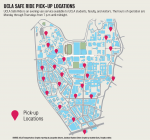You would expect administration at the university that created the internet to offer only the best digital services to its students. But the mobile app for UCLA’s evening transportation service glitches often and can’t even provide users with an accurate estimated time of arrival for their rides.
UCLA Safe Ride is the rebranding of the Community Service Officers’ Evening Van Service that students, faculty and campus visitors can use for free from 7 p.m. to midnight from Monday to Thursday. The van picks up and drops off students at 22 locations, including campus buildings, on-campus housing and nearby residential areas.
Riders used to have to call a CSO representative to request a van. As of fall 2017, however, riders can use the UCLA Safe Ride app created by the software provider TapRide. The service works like other ride-sharing services, such as uberPOOL and Lyft Line: Riders must request a ride on their phones and carpool with other students to their destination.
Free transportation from campus to dorms and apartments would typically attract a lot of students. However, few actually use this service because the vans’ stops are unmarked except for on the app, and the app has been known to glitch and provide unreliable estimated times of arrival for the pickup vans.
In fact, CSO manager Matt Ellis said the service served more students before it launched the app.
“We could definitely handle more passengers than we’re currently handling,” Ellis said. “We have run at a higher capacity in the past.”
To return ridership to past levels, UCLA Transportation and the CSO office should advertise UCLA Safe Ride more effectively and address the app’s bugs and glitches.
UCLA only advertises UCLA Safe Ride through the UCLA Transportation and CSO websites. Unlike the extended BruinBus hours or the new uberPOOL promotions, UCLA has not sent out promotional emails to inform students about the service. There are also no noticeable advertisement flyers or signs on campus.
Tanya Chowdhury, a fourth-year cognitive science student, said she hadn’t heard of UCLA Safe Ride at all during her time at the university.
“It’s probably not marketed or promoted well, because I’ve never heard of it or know anybody who uses it,” she said.
Norma Lopez Matias, a second-year Chicana and Chicano studies student, said she uses UCLA Safe Ride twice a week on average, but only found out about it through word of mouth.
“I had no idea it existed until I found out through a friend,” she said.
Poor advertising, however, is only one of the reasons why many students do not use the app.
The UCLA Safe Ride app routinely gives inaccurate estimated times of arrival. The app often indicates the wait time for a van is 20 minutes, which is the same amount of time it would take some students to walk to their destinations, even though the van is usually no more than five minutes away, Ellis said. It’s not hard to see why they would therefore forgo the supposed wait.
Ellis said he is aware of the app’s inaccurate ETAs and they are one reason why fewer students have been using the service. He added UCLA has been trying to work out the issue with TapRide.
It’s clear UCLA Transportation and the CSO office need to increase promotion for the UCLA Safe Ride app and fix bugs and glitches in the app that discourage students from using it in the first place. They should display signs at the vans’ stops and send out campuswide emails to advertise the service. These are methods the university used for other transportation services, and it wouldn’t be hard for UCLA to do the same to promote what is otherwise a very beneficial, yet underutilized, service to students.
Ellis said UCLA could better understand the app’s ETA glitches once more users use the service. However, UCLA Transportation and the CSO office must install signage and send out campuswide emails to attract new users. It also needs to fix the glitches that discourage students from using the app.
Though the university may claim UCLA Safe Ride offers students safe and reliable transportation, the service can’t improve campus safety with an unreliable system.
